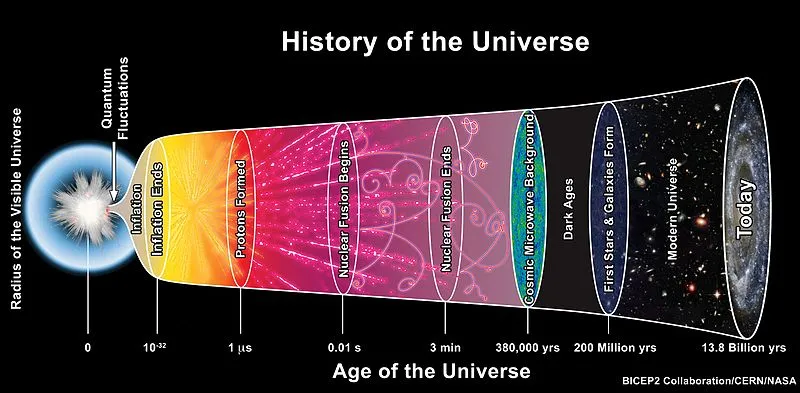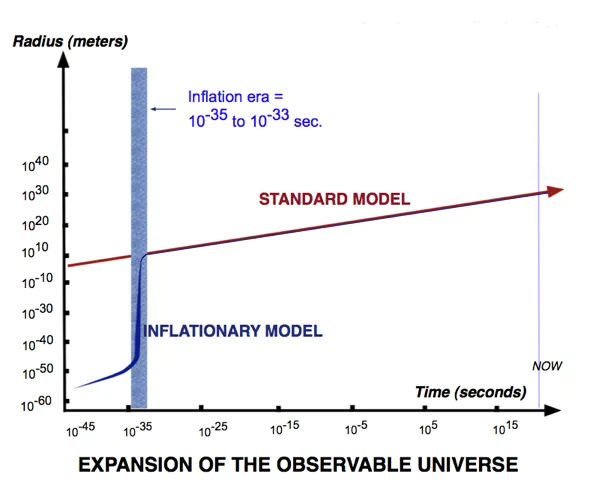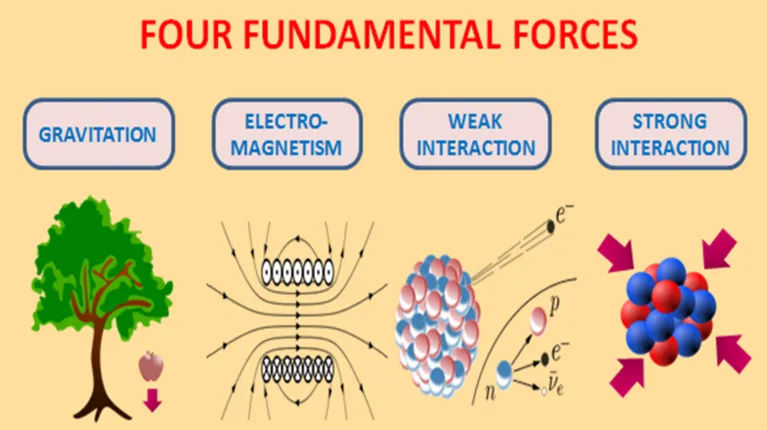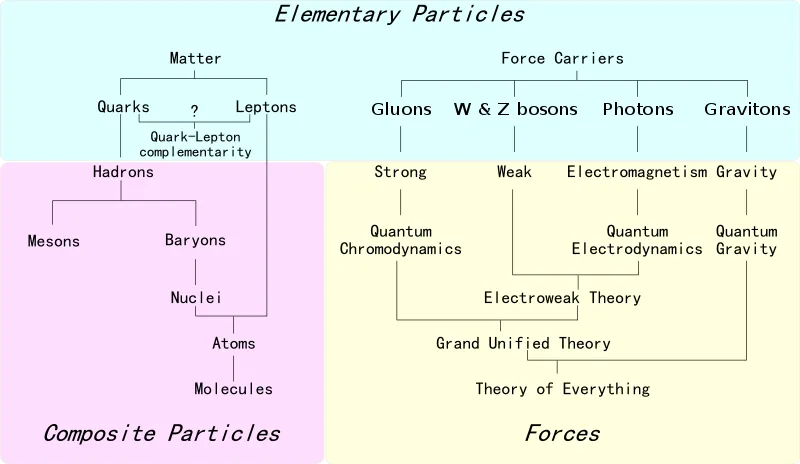Science has been known to provide answers to a lot of events in the world. From the mysterious day that suddenly went dark in May 19, 1780 in New England, of which many feared was the end of the world known as The Dark Day, to the fear of clustered asymmetric holes, a phobia which many have and which has a name: trypohobia. The psychological scientists seem to have zeroed in on the reason for this fear. Oh yes, it's a real fear borne out of our survival instinct.
Science for a long time have consistently tried to solve the homework given to it by nature, but sometimes some of the assignments are pretty tough and getting the answer may not be easy.
The Moment After The Big Bang
Just in case you have not heard, the Big Bang was that explosion that happened around 13.8 billion years ago that was the birth of the universe.
Moments (3mins) after the massive explosion, the temperature decreased to about 1 billion degree Celsius.
 The History of the Universe By TheAstronomyBum [CC0]
from Wikimedia Commons
The History of the Universe By TheAstronomyBum [CC0]
from Wikimedia Commons Fast forward to 300,000 years we now have a cooler Universe at 3000 degrees. The formation of atoms was possible as atomic nuclei combine with electrons. We now have the Universe that contains helium and hydrogen.
200 million years later, there was the formation of the first galaxies and stars. Here starts the era of the modern universe as we know it. Today, 13.8 billion years later, we have the Universe as we see it.
 A graph showing the addition of "inflation" (the microseconds rapid growth expansion in the 100 billion trillion trillion factor) which the original Big Bang Theory originally lacked. [CC0]
from Wikimedia Commons
A graph showing the addition of "inflation" (the microseconds rapid growth expansion in the 100 billion trillion trillion factor) which the original Big Bang Theory originally lacked. [CC0]
from Wikimedia Commons There is a name for that trillionth of a trillionth of a trillionth of a second after the big bang; 10-43 seconds is a pretty small number. It is known as the Plank Epoch which was the idea of the Max Plank, the physicist. He is the pioneer of quantum physics. In 1900 he described energy (light plus other electromagnetic waves) as quanta which define energy as something which is emitted in discrete packets. The values of which are as contained in the constant named after him - Planck constant.
Though his quantisation ideas was a formal assumption which got more development as Einstein builds on it, Max got a Nobel Prize in 1918 for his development of the quantum theory.
The Problem of the First Moment
The whole setup of the Universe initially starts off compressed to a single point and extremely hot. Then was then an explosion (Big Bang) which is followed by cosmic inflation. In other words, the Universe started expanding.
But like I mentioned above, just before the expansion that little period (0 to 10-43s) after the Big Bang with temperatures at 1032, is known as the Planck epoch.
The problem is how to describe what happened at that period. Easy? No. What is the problem? It is mathematical and no not that no one can solve, more as no one can reconcile it. Does it make any sense? Not surprised if it does not, but I am bringing more details.
The Universe four fundamental forces were all tied together.
 The Four Fundamental Forces By Kvr.lohith [CC BY-SA 4.0]
from Wikimedia Commons
The Four Fundamental Forces By Kvr.lohith [CC BY-SA 4.0]
from Wikimedia Commons The physics four fundamental forces are the strong forces (which holds nucleus together), the weak forces which handles the radioactive decay, electromagnetic force which is very much the force which exists between magnetic force and charges, and the last force the gravity, which like the electromagnetic force, has an infinite range and binds the solar system.
These forces separate into distinct forces and exhibit their characteristics as the temperature of the universe cool.
Now the problem I mentioned above is the inability to express the behaviour of these four forces mathematically as a single entity.
This difficulty is mainly down to the physics models available for explaining the dynamics/mechanism of the universe.
These two models are quantum mechanics which deals with subatomic states at nanoscopic levels; and Einstein's brainchild: the general relativity which looks at the distortion in space-time perceived as gravity, it looks at the effect of acceleration and gravity.
The incompatibility which the two models bring to the tables in the area of mathematics is the big bone of contention.
While the quantum camp is all about the probability of things being in a particular state or superposition, the general relativity side has everything mathematically defined in specific numbers giving no room for probabilities. Getting these two strange bedfellows together as obtainable during the Planck Epoch event using a mathematical model has proved more difficult to achieve. For lack of a better term, there is really no way of calculating the gravity using probabilities. The same is also true of the quantum mechanics; there are no mathematical means of expressing the quantum states in specific numbers, things are at best fuzzy. Reason: the rules don't apply.
The theory that can unify these different set of rules are ones a lot of scientists are looking for. Stephen Hawking was one of those scientists who has tried to make sense of the Theory of Everything; a theory unifying different fundamental laws of physics.
 An overview of particle physics showing the Theory of Everything By Headbomb [CC BY-SA 3.0]
from Wikimedia Commons
An overview of particle physics showing the Theory of Everything By Headbomb [CC BY-SA 3.0]
from Wikimedia Commons The idea is a hypothetical one which some believe to be a bit of a stretch. A view some do not agree with.
A Theory of Everything must account for the fact that the universe is "messy and complicated," he tells us, and for the limitations imposed by the questions we ask and the information we can obtain. The key lies in the remarkable capacity of mathematics to express the fundamental workings of the physical world--a language that the human mind is uniquely equipped to understand and manipulate. Barrow examines what mathematics actually is and describes how it makes the universe intelligible and provides a path to the underlying coherence in nature. Theories of Everything: The Quest for Ultimate Explanation
But until someone definitely comes up with that theory that sufficiently unifies these forces and express it as an equation, we will forever have some mystery about our Universe's first moment.
References
